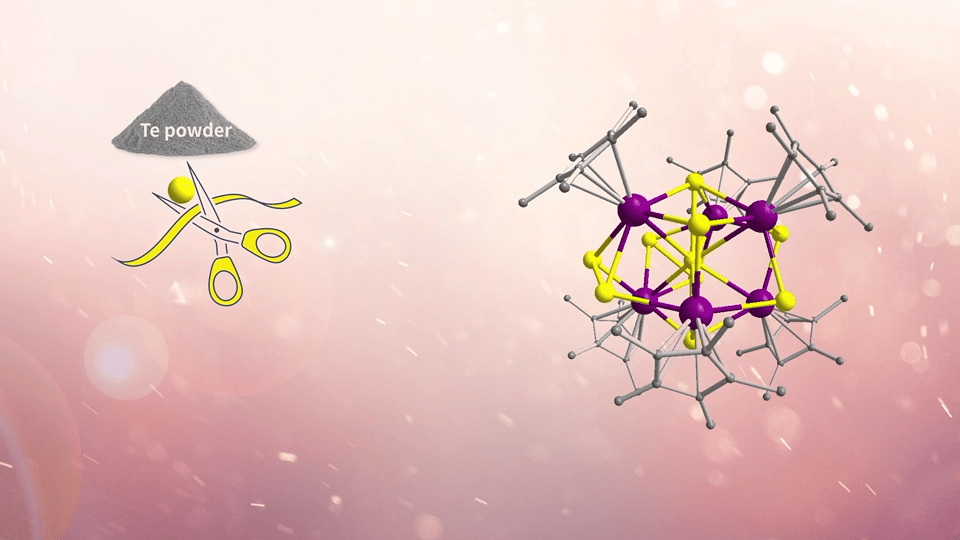As a new class of advanced functional materials, rare earth telluride exhibits abundant properties such as magnetic, electrical, thermoelectric, magnetic semiconductor, and charge density wave. However, the research and application of such materials are subject to two major challenges: one is the lack of convenient and universal preparation methods, and it is difficult to prepare rare earth telluride in high purity and large quantities; the other one is the lack of in-depth understanding of the electronic structure of materials.

In response to the above-mentioned challenges, Chair Professor Zhiping Zheng’s research group from the Department of Chemistry at the Southern University of Science and Technology (SUSTech) has made important progress in the construction of tellurium rare-earth clusters.
Their work, entitled “Atomically Precise Semiconductor Clusters of Rare-earth Tellurides”, has been published in Nature Synthesis, a journal covering organic, inorganic, organometallic, and materials chemistry.
Professor Zheng’s team envisioned the preparation and in-depth study of rare earth telluride by constructing tellurium-based rare earth clusters. Clusters can be regarded as bridge between molecules and bulk materials, and the study of atomically precise clusters is not only helpful to understand the structure-property relationship of materials, but can also be used as precursors to synthesize rare earth telluride materials with high purity, high crystallinity, and controllable composition. Based on this assumption, they synthesized five isomorphic rare earth telluride clusters [(Cp*RE)6(Te)3(Te2)2(Te3)] (Cp*: pentamethylcyclopentadienyl; RE = Y, Gd, Tb, Ho, Er).

Figure 1. Synthesis path of tellurium-based rare earth cluster RE6Te10 by reduction of elemental tellurium by KC8
The structure of the clusters was analyzed by X-ray single crystal diffraction, which not only contained the known Te2- and Te22- anionic ligands, but also contained an unreported linear tri-tellurido Te34- tellurium cluster ligand in the core structure of the cluster. DFT theoretical calculations of Y6Te10 clusters show that the Te34- ion unit is isoelectronic with the known XeF2 and I3– and has a special “three-center, four-electron” structure.
Energy decomposition analysis (EDA-NOCV) and orbital energy level analysis demonstrated that the strong interaction between metal atoms and tellurium cluster ligands is essentially derived from electrostatic interactions, and the rest is provided by Te(5p)→Y(4d) donor-acceptor interactions. In addition, solid-state UV-Vis-NIR spectroscopy showed that these clusters are a class of semiconductor materials with ultra-low band gaps comparable to monocrystalline silicon and gallium arsenide.
This method guides the construction of tellurium-based rare-earth clusters in the future, and the unique properties of such clusters make them potentially useful as futuristic quantum materials and for various optoelectronic applications.

Figure 2. Single crystal structure (a) of the [(Cp*RE)6(Te)3(Te2)2(Te3)]2- cluster, electronic structure of the linear tri-tellurium Te34- ligand (b-c) and Te22- ligand (d-e), and orbital energy level (f) of Y6Te10
Research Assistant Professor Yousong Ding and Ph.D. student Xuelian Jiang, both of the Department of Chemistry at SUSTech, are the co-first authors of the paper. Chair Professor Zhiping Zheng and Professor Jun Li of Tsinghua University are the co-corresponding authors, and SUSTech is the first corresponding institute of the paper.
This work was supported by the National Natural Science Foundation of China (NSFC), Key Laboratory of Rare Earth Chemistry of Guangdong Higher Education Institutes, Stable Support Plan Program of Shenzhen Natural Science Fund, Shenzhen Fundamental Research Program, National Key R&D Project, and the Guangdong Provincial Key Laboratory of Catalysis. Computational resources were provided by the Center for Computational Science and Engineering and the CHEM high-performance supercomputer cluster at SUSTech.
Paper link: https://www.nature.com/articles/s44160-024-00511-x.
To read all stories about SUSTech science, subscribe to the monthly SUSTech Newsletter.
Proofread ByAdrian Cremin, Yingying XIA
Photo ByDepartment of Chemistry